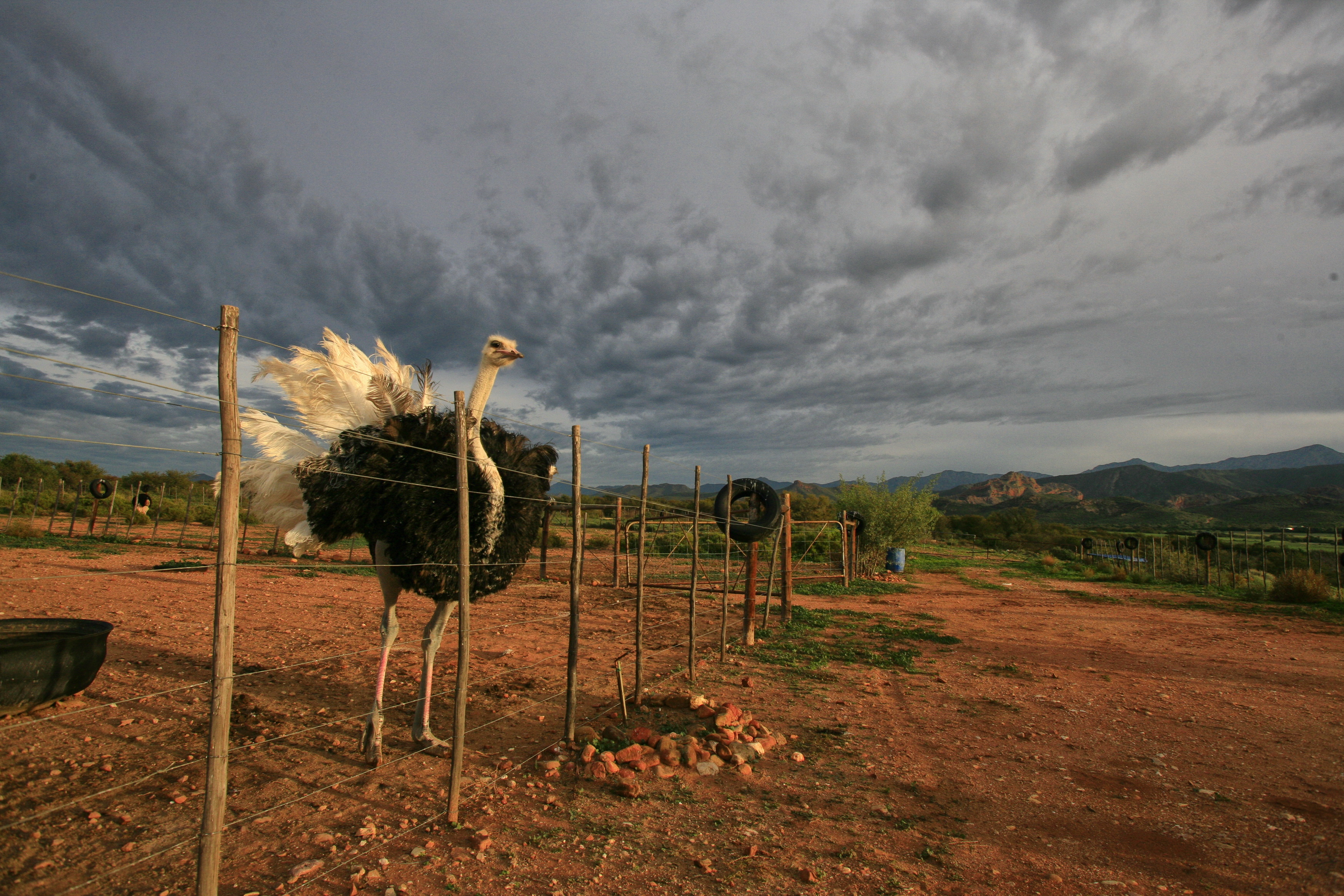I live in the Karoo and all around my home there are ostrich farms. Ostriches are very odd birds, being large and flightless. They are commonly thought to be indigenous to southern Africa, but are most probably Asian in origin.
The farmers in my area tell me one of the big advantages of farming ostriches is that they yield three different products: Ostrich skin is largely turned into leather products, mainly cowboy boots these days. Ostrich feathers, once very expensive fashion products, are alas not so any longer (ostrich feather boas and headdresses were killed off by the car industry because as cars got faster, they blew away). Sad.
And then, of course, there is the meat, which has the advantage of being healthier because it’s low-fat, low-cholesterol red meat, and the disadvantage of tasting awful — or at least I think so. I’m going to be lynched for that comment but, honestly, while some people like it, I find it a bit weird.
But there is one thing the ostrich does not do. It does not bury its head in the sand when it senses danger. This is a dastardly misconception perpetrated by the Romans, which has served for years as an analogy for avoiding problems by ignoring them. Ostriches dig shallow nests in the sand into which they drop their eggs. They turn the eggs several times a day, which creates the illusion of them burying their heads in the sand.
Still, the analogy is useful and never more than when it comes to the issue of climate change. For all the sceptics out there, just know that the science is now pretty unanimous. Like anti-vaxxers, there is a holdout group, but the consensus view is convincing. I know of course that there are falsities perpetrated in the name of climate change adherence and that there is a huge industry now premised on the notion. But there is also a huge industry premised on climate change being a hoax.
Climate change is one of those odd economic externalities that permits misconception because it’s been happening so slowly. My guess is that there are a lot of what you might call panic assumptions, perpetrated particularly on very hot days, when climate change is blamed for some unusual weather occurrence.
The combination of a variable record in the process of planetary heating, the mild changes that (most) people have experienced so far, and the huge industrial incentive to deny climate change have made for a fractious debate. But gradually, the tide is turning and it is refreshing to see that at COP28, participants have now, for the first time, agreed to transition away from fossil fuels in an attempt to reach global net zero emissions by 2050.
This is an improvement on the draft agreement which did not include the idea of a “phase-out” of fossil fuels — mainly at the instance of the oil-producing nations, which understandably don’t like the idea. A “transition away” is not as strong as a phase-out, but it’s better than nothing at all.
The question is whether this succession of historic agreements and ambitious targets is making sufficient difference on the ground — and the answer to that would be a hard “no”. Circa 2022, the average increase in the Earth’s temperature is 1.81°C. At this rate, which by the way is a slower rate of decline, by 2050, the average temperature will be 2.75°C warmer.
That means the world is going to get pretty hot. As my podcast co-pilot Mark Barnes points out in this week’s podcast, these increases might seem small, but if your body temperature increases by 1.5°C, then you are sick. Normal body temperature is 37.2°C. A temperature of 38 means you probably have a fever. At 40 you are a medical emergency and at 43 you are probably dead.
Thinking of it that way, this is serious stuff. There is another big problem and that is water. One thing that has become easy to measure has been the size of dams and lakes around the world, because for satellites to tally this information is now as easy as falling off a chair.
The Environmental Sciences department at the University of Colorado Boulder examined more than 250,000 satellite images spanning from 1992 to 2020 and what they discovered was “staggering”. Half the world’s dams have lost significant amounts of water, partly from increased use and partly from climate change, in almost equal measure.
Two of the US’s largest reservoirs, Lake Mead and Lake Powell, are sitting at half their average levels. The Aral Sea between Uzbekistan and Afghanistan used to be the fourth-biggest lake in the world and now it’s almost non-existent, although it began drying up years ago.
Some lakes are now much fuller, but oddly that’s not necessarily cause for celebration because they are being fed by melting glaciers, particularly in North America and the Tibetan Plateau. That underlines climate change rather than negating it. This is part of the problem with climate change: its effects are not consistent in place, time and effect.
This is something SA knows pretty well because Cape Town came very close to being the first major city in the world to run out of water. The scenario of a water war used to be the subject of science fiction. No longer. DM
https://www.youtube.com/watch?v=REeWvTRUpMk
Business Maverick
After the Bell: Fighting the head-in-the-sand approach to the climate crisis





